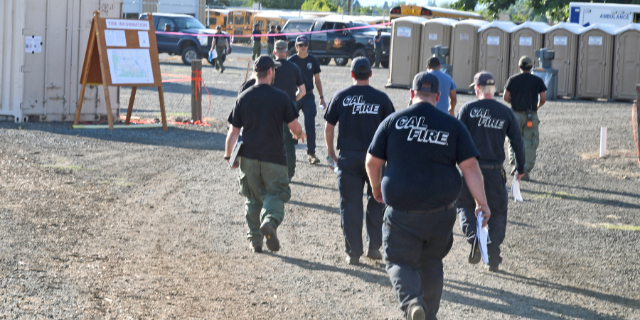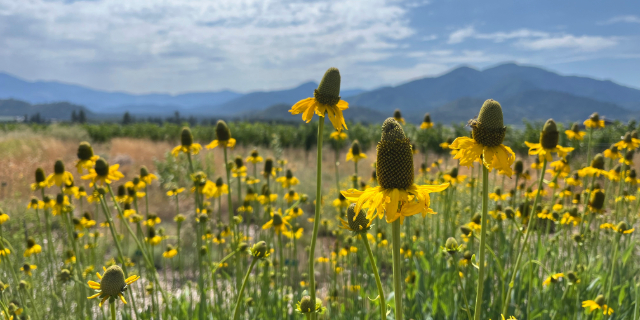Burned hatchery still producing a million fish annually
Published 6:00 am Thursday, March 9, 2023

- The office complex at the Klamath Fish Hatchery was reduced to rubble by the 2020 Two Four Two Fire in 2020, but the hatchery continues to produce trout that are stocked in Southern Oregon lakes.
The Klamath Fish Hatchery is still operating and producing legal- and trophy-size rainbow trout even though its main building was destroyed in the September 2020 Two Four Two Fire near Chiloquin.
Trending
The hatchery, located along Crooked Creek off Highway 62 south of Fort Klamath, is still producing about a million fish annually, mostly rainbow trout, along with smaller numbers of brown trout and chinook salmon, according to hatchery manager Greg Lipsiea, and Scott Patterson, fish propagation manager for the Oregon Department of Fish and Wildlife.
Fingerling trout are planted in nearby wilderness areas, including the Mountain Lakes and Sky Lakes wilderness areas, while larger trout are planted at such lakes as Diamond Lake and Lake of the Woods.
Lipsiea said the blaze destroyed the 225-by-75-foot office complex — “The heart of the hatchery” — that also housed the main mechanical shop. The hatchery’s power, water and sewer systems were also compromised. He and Patterson said they hope construction of a new building can begin later this year and that the hatchery will reopen to public visits in 2024. Tentative plans have the new structure housing the hatchery’s offices, maintenance shops, visitor center and restrooms.
Trending
“We’ll definitely build it back better,” he said, noting the destroyed structure was built in the 1950s. “We’re just so sorry we haven’t been able to open up to the public. The hatchery remains closed to public visits because of concerns about fallen trees and the potential for falling rocks.
“The road is a bit of a hazard,” Lipsiea said, noting what was the office complex is now a “hole in the ground.”
Despite the extensive damage, “We haven’t had a hiccup in production,” Lipsiea said of ongoing efforts to raise fish. Eggs from the Klamath hatchery were taken to other state hatcheries, where they were hatched and kept until young fish were large enough to be returned to the Klamath hatchery to be reared.
When the rainbow trout are released, some are fingerlings about 2 to 4 inches long, others are 10 inches, while upwards of 16,000 are 2-pound trophy trout. The rainbows are stocked in lakes and streams throughout Southern Oregon, including Lake of the Woods, several lakes in Lake County, and Diamond Lake, which Lipsiea terms “one of the best productive lakes in the state.”
The fingerlings are stocked by helicopter into wilderness lakes every other year, with the next planting planned in July.
The hatchery also raises triploid brown trout. Although an estimated 50,000 inside a tank in the building died from the blaze, Lipsiea said production has continued because of assistance from other hatcheries. Brown trout, a non-native species, are planted in Lake of the Woods, Crescent Lake and Miller Lake in Klamath County, Paulina Lake and East Lake in Deschutes County, along with limited numbers at Withers Lake in Lake County.
The spring chinook salmon are part of small pilot program to determine whether they can migrate from rivers that flow downstream into Upper Klamath Lake. Some of the 10,000, 6-inch-long fingerlings have radio transmitters that allow them to be tracked.
“So far, we’ve seen the first release was successful,” Lipsiea said.
The hatchery has 20 outdoor ponds that vary in size and depth: nine are 20-by-100-foot long and 4 feet deep; three are 10-by-20-foot long and 3 feet deep; and seven others are 10-foot deep. The hatchery also has a natural earthen pond.
While fish-raising efforts are continuing, Patterson said it’s uncertain when the office complex will be rebuilt. Despite several delay-causing hurdles, Patterson said he hopes construction at the hatchery, which could cost upwards of $6 million, will begin this summer or fall.
“We’re moving forward,” Patterson said. “We’ve been dealing with the process for two years.”
When a new office is built, he said, it will likely be designed to be more fire resistant and have other upgrades. He said the process is lengthy because it requires receiving approvals from insurance companies, the Department of Justice, the Federal Emergency Management Agency and others. The process has also involved working with the Klamath Tribes on archeological studies, which found no evidence of artifacts.
The Klamath Fish Hatchery was among four state-operated facilities damaged or destroyed during the late summer of 2020. The Two Four Two Fire began on Fremont-Winema National Forest lands near Collier Memorial State Park. The fire burned nearly 14,500 acres between Highway 97 and Highway 62. Several homes and other structures, along with propane tanks, fuel tanks and powerlines, were damaged or destroyed. It also burned more than 800 acres north of the Train Mountain Railroad Park, which features a unique railroad museum and offers public rides on cars pulled by small-scale trains.
The fire did not damage the hatchery’s four permanent residences.
“The firefighters did an amazing job,” Lipsiea said.









